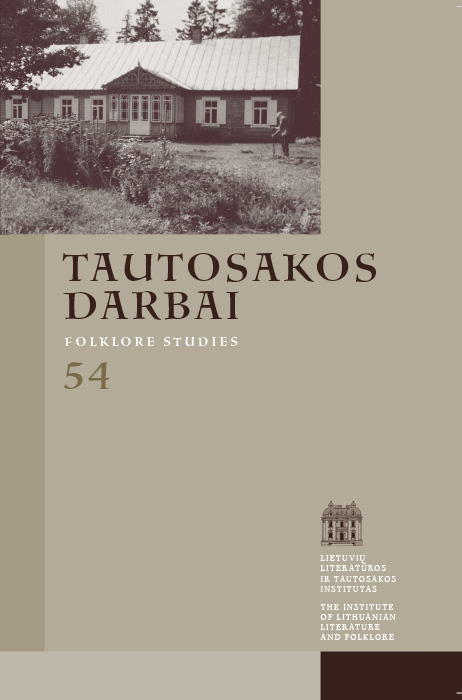Mįslių suvokimo raida: nuo refleksijos tradicinėse mįslėse iki termino metaforinio išskydimo masinėse žiniasklaidos priemonėse
Santrauka
Straipsnyje aptariamas mįslių kaip žanro suvokimas ir jo raida jų vartojimo aplinkoje. Darbą sudaro dvi dalys – pirmoji skirta tradicinei vartosenai; čia pradedama nuo refleksijos, kai apie mįsles kalbama mįslėse, su mįslėmis ir jų minimu susijusių žodžių, mįslių prigimties ir paskirties suvokimo pasakojamojoje tautosakoje, įvairiose minimo situacijose. Pirmosios dalies medžiaga – tradicinės lietuvių mįslės, iš rankraštinių šaltinių ir publikuotos, sakmės bei pasakos, kuriose minimos mįslės, žodžių aiškinimai Lietuvių kalbos žodyne. Antrojoje dalyje, daugiausia remiantis straipsnio autorės maždaug pastaruosius trejus metus fiksuota medžiaga gyvenamojoje aplinkoje, socialiniame tinkle Facebook, interneto žiniasklaidoje, analizuojama šiuolaikinė mįslių ar joms artimų reiškinių vartosena. Tradicinėje vartosenoje žodis mįslė dažniausiai turi tiesioginę reikšmę, t. y. vartojamas kaip žanrą įvardijantis terminas. Kai apie mįsles kalbama mįslėse, labiausiai pabrėžiama intelektuali jų prigimtis, jų minimas vaizduojamas kaip įtemptas ir atsakingas užsiėmimas, kuriuo galima pademonstruoti savo žinias, protą ir kūrybingumą, o paskui būti apdovanotam arba nubaustam. Mįslių minimo situacijos, vaizduojamos pasakojamojoje tautosakoje, apipintos bauginimais ir draudimais, šis procesas suvoktas kaip nesaugus, keliantis grėsmę, o visas žanras greičiausiai buvęs priskirtas chtoniškųjų jėgų įtakos sferai. Nors šiuolaikinėje vartosenoje klasikinės mįslės aptinkamos retai, tačiau pakitusiomis formomis ir dabar išlaikoma dauguma mįslių funkcijų ir jas dominančių temų.
Atsisiuntimai
Skaitomiausi šio autoriaus(ų) straipsniai
- Aelita Kensminienė, Šiuolaikinė mįslių vartosena Lietuvoje , Tautosakos darbai: T 64 (2022)
- Aelita Kensminienė, Lietuvių mįslės apie puodą – žmogaus gyvenimo alegorijos , Tautosakos darbai: T 61 (2021)
- Aelita Kensminienė, Mįslė apie kalbančią plunksną: motyvų klajonės , Tautosakos darbai: T 58 (2019)
- Aelita Kensminienė, Mįslės apie raštą, jungiamos lauko vaizdavimo , Tautosakos darbai: T 50 (2015)
